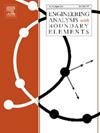利用物理信息神经网络 (PINN) 解决空间索洛模型正演和反演问题的新方法
IF 4.2
2区 工程技术
Q1 ENGINEERING, MULTIDISCIPLINARY
Engineering Analysis with Boundary Elements
Pub Date : 2024-10-30
DOI:10.1016/j.enganabound.2024.106013
引用次数: 0
摘要
空间索洛模型可以考虑地理上的相互依存性和经济活动的空间组织,并能更好地理解经济增长。在这项工作中,利用物理信息神经网络(PINNs)方法求解了空间索洛模型的支配方程,并考虑了正向和反向问题。在正向问题中,求解了考虑和不考虑技术进步的条件,并将结果与现有结果进行了验证,结果一致。对于逆向问题,利用非常稀疏的数据点进行了生产函数的参数识别。对于无噪声数据,只需使用 2 个数据点即可估计生产函数的两个参数,误差可低于 3%。对于低水平噪声数据,也可以用 30 个数据点对参数进行反演,两个参数的误差均小于 1%。本文章由计算机程序翻译,如有差异,请以英文原文为准。
A new method to solve the forward and inverse problems for the spatial Solow model by using Physics Informed Neural Networks (PINNs)
The spatial Solow model can take into account the geographical interdependence and the spatial organization of economic activities, and offers a better understanding of economic growth. In this work, governing equations of the spatial Solow model were solved by using the Physics Informed Neural Networks (PINNs) method, and both the forward and inverse problems were considered. For the forward problems, the conditions with and without considering the technology progress were solved, and the results were validated against the existing ones and good agreement can be found. For the inverse problems, the parameter identification of the production function was conducted by using very sparse data points. For the data without noise, two parameters of the production function can be estimated by using only 2 data points, where the errors can be below 3 %. For the low level noisy data, the parameters can also be inversed with 30 data points, and the errors for the two parameters were both less than 1 %.
求助全文
通过发布文献求助,成功后即可免费获取论文全文。
去求助
来源期刊

Engineering Analysis with Boundary Elements
工程技术-工程:综合
CiteScore
5.50
自引率
18.20%
发文量
368
审稿时长
56 days
期刊介绍:
This journal is specifically dedicated to the dissemination of the latest developments of new engineering analysis techniques using boundary elements and other mesh reduction methods.
Boundary element (BEM) and mesh reduction methods (MRM) are very active areas of research with the techniques being applied to solve increasingly complex problems. The journal stresses the importance of these applications as well as their computational aspects, reliability and robustness.
The main criteria for publication will be the originality of the work being reported, its potential usefulness and applications of the methods to new fields.
In addition to regular issues, the journal publishes a series of special issues dealing with specific areas of current research.
The journal has, for many years, provided a channel of communication between academics and industrial researchers working in mesh reduction methods
Fields Covered:
• Boundary Element Methods (BEM)
• Mesh Reduction Methods (MRM)
• Meshless Methods
• Integral Equations
• Applications of BEM/MRM in Engineering
• Numerical Methods related to BEM/MRM
• Computational Techniques
• Combination of Different Methods
• Advanced Formulations.
 求助内容:
求助内容: 应助结果提醒方式:
应助结果提醒方式:


